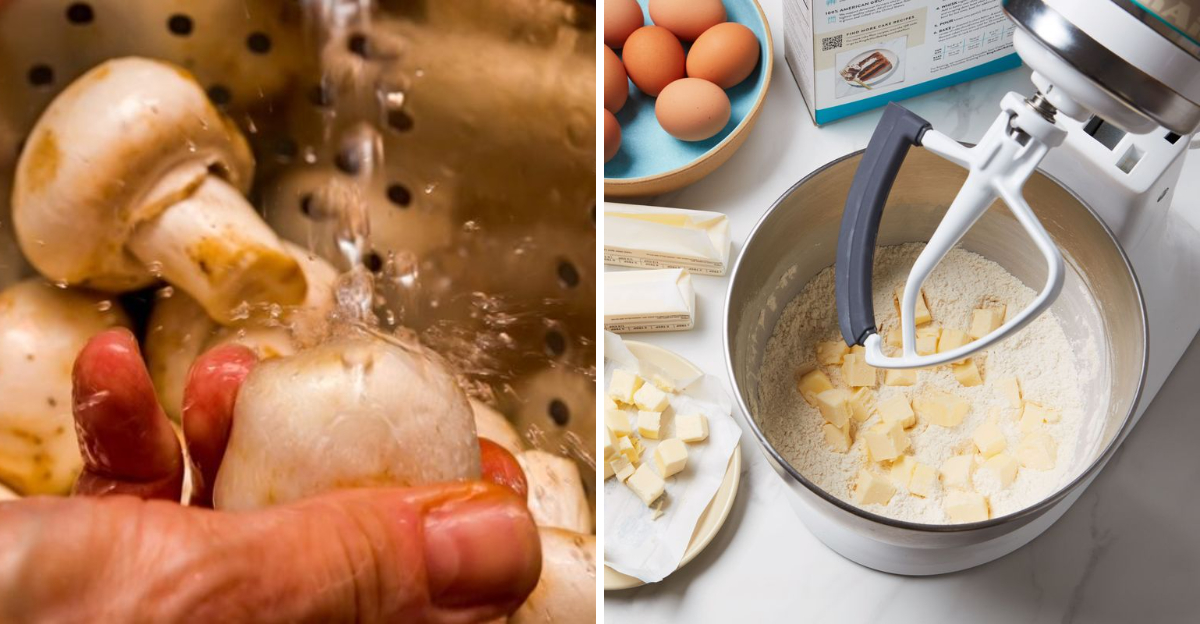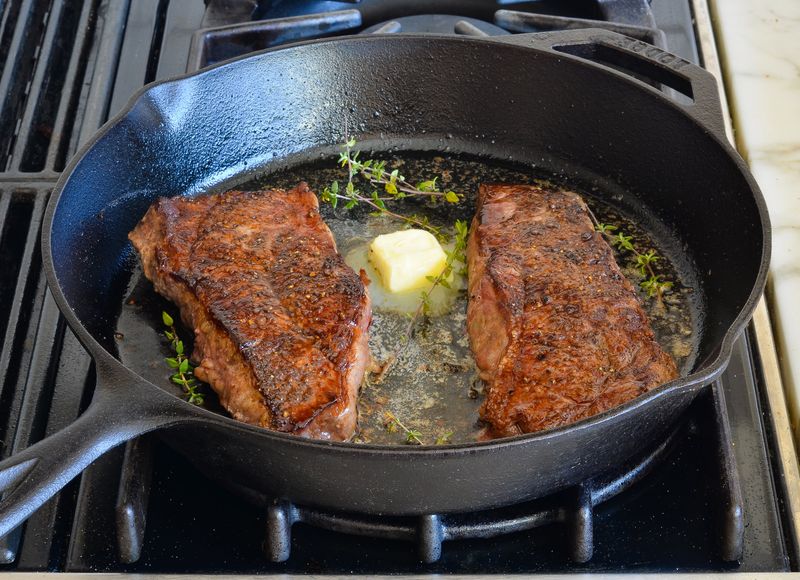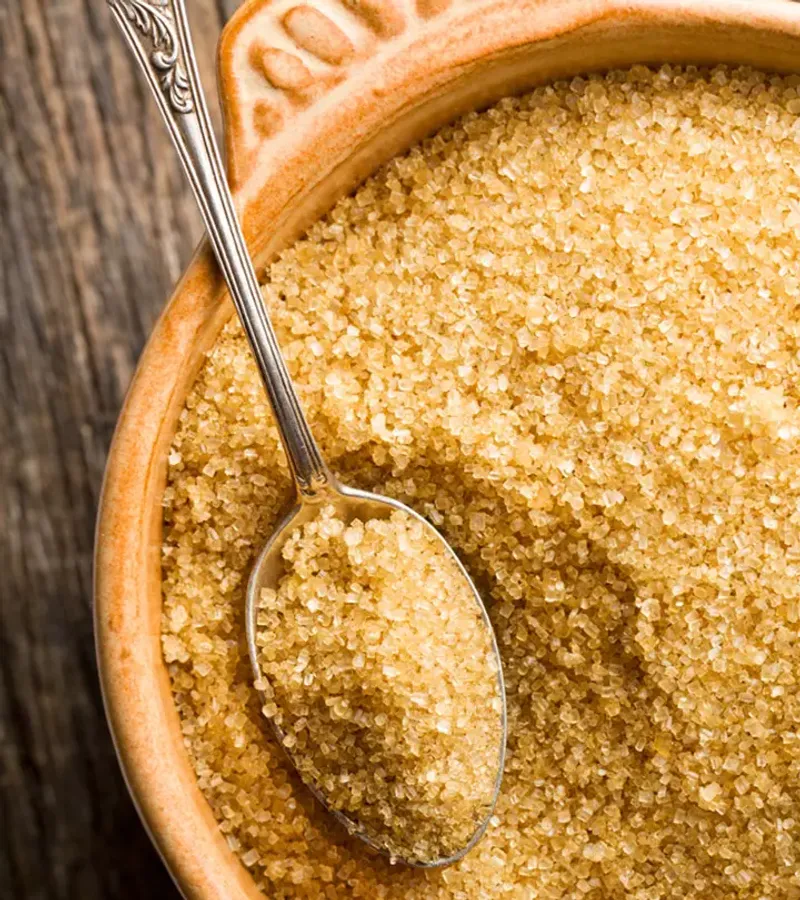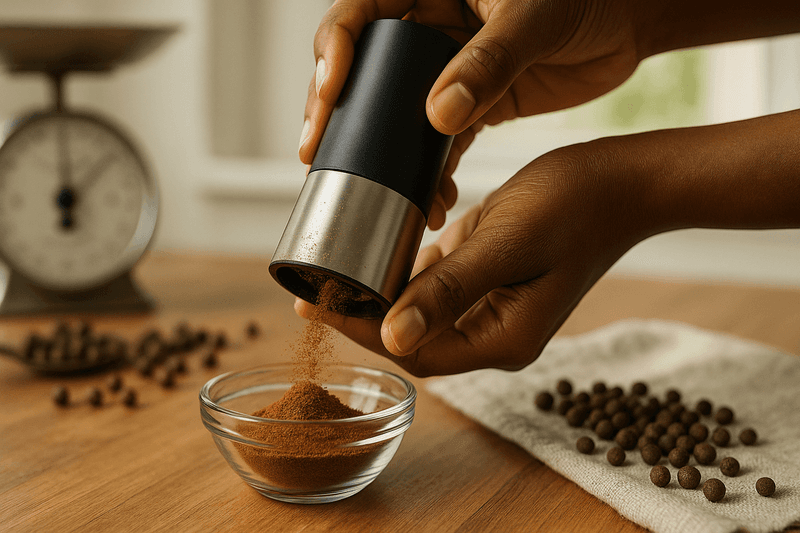Ranked: 33 Common Cooking Tips That Are Actually Bad Advice

Cooking is an art that requires experimentation and understanding, but sometimes well-intentioned advice can lead us astray. Here are 33 cooking tips that are commonly mistaken as helpful but might be doing more harm than good in your kitchen.
1. “Only flip your steak once.”

The wisdom of flipping a steak just once is outdated. Flipping frequently allows for even cooking and a beautifully formed crust without overcooking the inside. This technique helps the steak retain its juices better and cook to perfection. It’s a simple adjustment that can transform a steak from good to great. Previously, single flipping might have been seen as the expert method, but modern chefs know better. Try it next time, and you might be surprised by the results. Flipping isn’t only fun, it’s flavorful. Your taste buds will thank you!
2. “Sear meat to lock in juices.”

Searing meat is often touted as a way to lock in juices. In reality, it doesn’t seal anything but instead enhances flavor by creating a savory crust. The myth persists that searing traps moisture, but moisture loss happens regardless. Searing should be appreciated for its ability to add depth and complexity to meat dishes, not for sealing. This misunderstanding might stem from the satisfying sizzle sound, but science tells us otherwise. Embrace searing for flavor, not for moisture retention. Your dishes will burst with taste, not trapped juices.
3. “Salt beans at the end or they’ll never soften.”

The belief that salting beans too soon makes them tough is an old tale. In fact, adding salt early in cooking helps season the beans thoroughly. Salt does not inhibit softening when beans are cooked properly. This myth likely arose from past misunderstandings. By salting early, you ensure that every bean is infused with flavor. Rather than withholding salt, embrace it to enhance your dishes. It’s a simple change that makes a big difference. Your beans will be tender and flavorful, simply by seasoning thoughtfully from the start.
4. “Use oil in your pasta water to prevent sticking.”

Adding oil to pasta water is believed to prevent sticking, but it merely floats on the surface. Instead of helping, it can prevent sauce from clinging later. To truly prevent sticking, stir your pasta often as it cooks. This age-old myth persists despite its ineffectiveness. Oil might appear to coat the pasta, but it does more harm than good. Leave the oil for dressing your pasta after cooking. For beautifully sauced pasta, focus on stirring rather than oiling. Your dishes will benefit from this simple, effective technique.
5. “Always rinse mushrooms.”

The notion that mushrooms should never be rinsed is outdated. A quick rinse won’t make them soggy as believed. Mushrooms don’t absorb water like sponges; soaking does that. Rinsing removes dirt efficiently without sacrificing texture. This myth might stem from past mushroom cultivation practices. Modern mushrooms can handle a rinse. Rather than brushing meticulously, try a gentle rinse for convenience and cleanliness. It’s a small change that saves time and keeps flavor intact. Mushrooms remain deliciously satisfying, ready for your culinary endeavors.
6. “Use cold butter for everything.”

Cold butter isn’t always the answer, especially not for creaming. Softened butter traps air, vital for fluffy baked goods. The myth of always using cold butter might stem from its benefits in specific recipes. However, for cakes and cookies, room temperature butter is key to perfect texture. Embrace softened butter for airy, delightful treats. This simple adjustment transforms your baking, letting flavors shine. Don’t let old advice hold you back from achieving baking bliss. With the right butter consistency, your creations will rise to the occasion. Enjoy the difference!
7. “Don’t use metal in nonstick pans — ever.”

The warning against using metal in nonstick pans is generally sound, but high-quality coatings can handle gentle metal contact. Misuse might have fueled this myth. For cheap pans, stick to wooden or silicone utensils. However, with care, metal can be used without damage. This flexibility broadens your kitchen tool options. Handle with care, and your pans will last. By understanding your cookware’s quality, you make informed choices. Embrace versatility without compromising longevity. It’s about knowing when metal makes sense, transforming your cooking experience.
8. “The more garlic, the better.”

Garlic is loved for its robust flavor, but too much can overpower. More isn’t always better. Balance is key to enhancing a dish without overwhelming it. The myth of more garlic might arise from its aromatic appeal. However, restraint allows all ingredients to shine. Burnt garlic can ruin a dish with bitterness. Embrace garlic’s potential by using it thoughtfully. By balancing flavors, you create harmony in your dishes. It’s a delicate art, understanding when enough is enough. Savor the richness without losing subtlety. Enjoy complexity, not just intensity.
9. “Always preheat your pan before adding oil.”

Preheating a pan before adding oil has its merits but isn’t universal. For delicate oils like butter, preheating the oil avoids burning. The myth might stem from generalizing specific techniques. Understanding what you’re cooking allows you to choose the right method. It’s about adapting to your ingredients, ensuring optimal results. Missteps happen when advice is taken without context. Learn when to preheat and when to add oil earlier. It’s a balance that enhances your culinary creations, ensuring flavors are preserved, not burnt. Cook with confidence, knowing the right moments.
10. “Baking is exact, so never experiment.”

Baking is often seen as a science, but there’s room for creativity. Once you understand ratios, experimenting is possible. This myth stifles innovation, discouraging curious bakers. Embrace the excitement of trying new combinations. It’s part of the joy of baking. Mistakes lead to discoveries, and with knowledge, you find success. Baking is about precision, but also expression. Don’t let fear of failure stop you. Your kitchen becomes a lab of delightful possibilities. Break free from constraints and let your imagination rise. Baking isn’t just science; it’s an artful adventure.
11. “Microwaves kill nutrients.”

The belief that microwaves destroy nutrients is misleading. Microwaving often retains nutrients better than boiling due to shorter cooking times. This myth persists despite evidence to the contrary. Embrace the convenience and nutrition of microwave cooking. It’s an efficient way to prepare meals without sacrificing health benefits. The misconception might arise from misunderstanding technology. Microwaves simplify cooking, keeping flavors and nutrients intact. Trust in your microwave for quick, nutritious meals. It’s a tool that preserves as much as it cooks. Enjoy the ease and health it offers, debunking myths.
12. “Always wash raw chicken.”

Washing raw chicken is thought to remove bacteria, but it can spread them instead. Cooking kills pathogens, rinsing doesn’t. This advice is rooted in outdated safety practices. Embrace modern methods for kitchen hygiene. Avoid unnecessary risks by trusting cooking temperatures. The myth might persist from visual reassurance, but science supports cooking as the solution. By skipping the rinse, you protect your kitchen and health. It’s a simple change with significant impact. Cook confidently, knowing you’re minimizing contamination. Safety lies in temperature, not washing.
13. “Marinate meat for hours to make it tender.”

Marinating for tenderness is often overestimated. While it adds flavor, it doesn’t penetrate deeply. Over-marinating can lead to mushy textures or sour tastes. The myth might stem from past misunderstandings of marinades’ effects. Focus on flavor enhancement rather than tenderness. A few hours suffice for delicious results. This adjustment prevents disappointment and preserves texture. Embrace balanced marination for delectable dishes, not tenderizing. It’s about knowing when enough is enough, creating depth without overdoing. Your meals will benefit from thoughtful marination, elevating taste without compromise.
14. “Boil vegetables to make them soft.”

Boiling vegetables is a common mistake for softness, leaching nutrients and flavor instead. Steaming or roasting offers better texture and taste. The myth of boiling’s effectiveness might arise from outdated cooking practices. Embrace alternative methods for vibrant, nutrient-rich vegetables. This small change enhances your meals, preserving what’s essential. Boiling reduces vegetables to blandness, while roasting brings out their natural sweetness. Discover the joy of perfectly cooked vegetables, full of life and flavor. It’s about knowing the best techniques for delicious results. Enjoy the bounty of nature, wisely prepared.
15. “Use lemon juice to cook fish.”

Lemon juice can flavor fish but doesn’t fully cook it safely. Proper ceviche requires careful handling. The myth might stem from misunderstanding acid’s effects. Embrace lemon for zest, not cooking. This distinction ensures safety and flavor. Cooking fish with heat guarantees thoroughness, while lemon brightens the taste. It’s about knowing where lemon shines, enhancing rather than replacing methods. Enjoy the freshness it brings without risking undercooked fish. Your dishes will burst with flavor while ensuring safety. Trust in the right techniques for delightful fish dishes.
16. “Only use clarified butter for high-heat cooking.”

Clarified butter excels at high temperatures, but regular butter suffices in many cases. Watching for browning is key. The myth of exclusive clarified butter use might arise from a focus on smoke points. Understand when regular butter works without burning. It’s about balancing flavor and heat management. Embrace the versatility of butter in your cooking. By knowing the limits, you expand your culinary repertoire. Enjoy the richness it provides without unnecessary constraints. Cooking becomes more flexible and flavorful with informed butter choices. Your dishes will benefit from this nuanced approach.
17. “You must sift flour every time.”

Sifting flour isn’t always necessary. This myth might stem from older recipes where consistency was key. Modern milling means flour is finer, often not requiring sifting. Understand when texture or mixing benefits from it. Embrace the freedom to choose based on recipe needs. This flexibility enhances your baking experience, saving time without sacrificing quality. Sift for specific purposes, not as a rule. By recognizing when it matters, you bake better. It’s about knowing when tradition meets modern convenience. Enjoy the ease and success of thoughtful baking, not rigid rules.
18. “Add oil to keep rice from sticking.”

Oil in rice water is thought to prevent sticking, but it doesn’t. Rinsing rice before cooking is more effective. This myth might arise from confusion over texture control. Embrace rinsing as the solution, ensuring fluffy rice. It’s a simple change that makes a significant difference. Oil doesn’t solve stickiness, but washing does. Your rice will be a shining example of perfect preparation. It’s about understanding the true methods for desired results. Enjoy the satisfaction of beautifully cooked rice, free from unnecessary oil. Your dishes will be enhanced by this clarity.
19. “Cooking wine is fine for recipes.”

Cooking wine is often salty and low quality, leading to poor flavor. Use drinkable wine for the best results. This myth might stem from convenience, but quality matters. Embrace real wine to elevate dishes. It’s a small change with a profound impact on taste. Cooking wine doesn’t provide the depth or richness you desire. Trust in good wine to transform your recipes, enhancing rather than compromising. Your meals will reflect this thoughtful choice, full of flavor and sophistication. It’s about knowing what enhances, not just suffices.
20. “All herbs go in at the beginning.”

Adding herbs at the start can dull their flavor, especially fresh ones. They should often be added at the end. Dried herbs are different, releasing flavors over time. This myth might arise from misunderstanding herb characteristics. Embrace the timing that preserves the vibrant taste of fresh herbs. It’s a vital part of crafting flavorful dishes. By knowing when to add herbs, you enhance complexity and aroma. Trust in this subtle art for delicious results. Your cooking will sing with freshness and depth, simply by honoring herb timing.
21. “Letting food cool before refrigerating prevents spoilage.”

The belief that cooling prevents spoilage is false. Leftovers should go in the fridge within 2 hours to avoid bacteria growth. This myth might stem from past practices when cooling was necessary to avoid condensation. Embrace modern refrigeration safety. It’s about minimizing risk, not maximizing cooling time. By acting swiftly, you ensure food safety. Trust in refrigeration to protect what you’ve prepared. This simple step keeps meals safe without extra cooling. Enjoy peace of mind along with your leftovers, knowing you’ve taken the right precautions.
22. “Brown sugar is healthier than white sugar.”

Brown sugar might seem healthier, but nutritionally, it’s almost identical to white sugar. The myth likely arises from its molasses content, which adds color and a hint of flavor. Embrace sugar choices based on taste preference rather than health assumptions. It’s a small distinction that matters more to flavor than nutrition. By understanding this, you make informed choices in baking and cooking. Trust in your taste buds, not myths, to guide your sugar use. Your dishes will benefit from clarity and authenticity. Sweetness is a matter of flavor, not false health promises.
23. “The toothpick test always works for cakes.”

The toothpick test is a classic but not foolproof. It fails with melted chocolate or fruit in the cake. Check with a gentle press or temperature reading for accuracy. This myth persists from simplicity, but cakes deserve more care. Embrace multiple methods to ensure doneness. It’s about knowing when tradition meets modern precision. By understanding your cake’s unique needs, you bake with confidence. Your creations will reflect this thoughtful approach, ensuring perfection. Trust in a combination of tests for truly satisfying results. Baking becomes an art of precision and touch.
24. “Don’t open the oven while baking.”

Peeking into the oven might seem risky, but quick checks won’t ruin most baked goods. This myth stems from fear of heat loss, but with care, it’s manageable. Embrace awareness over caution. It’s about knowing your recipe and oven behavior. With confidence, you master the art of timing. Missteps happen, but learning from them enhances skills. Trust in your instincts alongside instructions. Your baking will benefit from attentive observation, not rigid rules. Enjoy the process of baking, understanding when and how to check without fear. It’s an artful dance of observation and timing.
25. “More spice equals more flavor.”

Spices add flavor, but more isn’t always better. Balance enhances complexity, not overpowering. The myth of more spices might arise from love for boldness. Embrace harmony to create depth and richness. It’s about knowing when enough is enough. By measuring thoughtfully, you discover new dimensions of flavor. Trust in your palate to guide spice use. Your dishes will reflect this precision, full of nuance and interest. Enjoy the art of seasoning, creating layers rather than intensity. Cooking becomes an exploration of flavors, crafted with care and understanding.
26. “Cook pasta until it’s completely soft.”

Cooking pasta to softness misses the mark on texture. Al dente offers a satisfying bite, holding sauces beautifully. The myth of complete softness might stem from confusion over doneness. Embrace timing for perfect pasta. It’s about knowing when to stop for ideal results. By tasting as you go, you achieve culinary excellence. Trust in the feel of your pasta, not rigid timing. Your dishes benefit from this attention to texture, elevating your dining experience. Enjoy the balance of tender and firm, crafted with care and precision. Pasta becomes a testament to thoughtful cooking.
27. “Raw food is always healthier.”

Raw isn’t a guarantee of health. Cooking can enhance nutrient absorption in foods like tomatoes and spinach. This myth might arise from a misunderstanding of nutritional science. Embrace both raw and cooked for a balanced diet. It’s about knowing when cooking enhances or diminishes. Trust in diverse preparation methods for optimal health. Your meals will benefit from variety, offering both flavor and nutrition. Enjoy the richness of cooked foods alongside fresh, understanding the benefits of each. Cooking becomes a celebration of nourishment, crafted with wisdom and taste.
28. “You must rest all meats for 10+ minutes.”

Resting meat is important but varies by cut. A thin chicken breast doesn’t need the same time as a roast. The myth of universal resting might stem from oversimplification. Embrace understanding of your meat’s needs for best results. It’s about knowing the impact of resting on juices and texture. By adapting rest times, you enjoy perfectly cooked meals. Trust in your knowledge of meat to guide you. Your dishes will reflect this attention to detail, offering juicy and flavorful results. Enjoy the art of resting meat, tailored to each meal.
29. “Frozen vegetables are less nutritious.”

Frozen vegetables are often picked and frozen at peak ripeness, sometimes preserving more nutrients than fresh. This myth might stem from a bias towards fresh produce. Embrace the convenience and nutrition of frozen options. It’s about understanding that preservation methods enhance accessibility to nutrients. Trust in frozen vegetables to offer health benefits year-round. Your meals will reflect this choice, offering both flavor and convenience. Enjoy the ease of cooking with frozen produce, knowing you’re not compromising on quality. It’s a modern approach to nutrition, full of promise and practicality.
30. “Oil stops butter from burning.”

Combining oil with butter raises smoke points slightly but not enough for high heat. This myth might arise from misunderstanding smoke dynamics. Embrace caution when cooking with butter. It’s about knowing the limits and adapting techniques for flavor. By understanding this, you ensure delicious results without burning. Trust in your knowledge of fats to guide cooking. Your dishes benefit from this understanding, offering richness without compromise. Enjoy the art of cooking with butter, balancing flavor and technique. It’s a nuanced dance of temperature and taste, crafted with care.
31. “Teflon is toxic when scratched.”

Teflon is stable under normal use, with toxicity concerns only at extremely high temperatures. The myth might arise from misunderstanding material science. Embrace careful use without fear. It’s about knowing the limits and maintaining cookware. Trust in quality pans for safe cooking. Your kitchen benefits from this understanding, offering longevity and performance. Enjoy the ease of Teflon, appreciating its role in modern cooking. It’s a tool that balances convenience and safety, crafted for thoughtful use. Your culinary adventures thrive with Teflon, free from the burden of unfounded fears.
32. “Sea salt is healthier than table salt.”

Sea salt and table salt have the same sodium content, differing mainly in texture and taste. The myth of health differences might arise from marketing. Embrace salt choices based on flavor rather than misconception. It’s a small distinction that matters more to culinary experience than health. By understanding this, you make informed choices in seasoning. Trust in your palate to guide salt use, enhancing dishes without false health promises. Your cooking benefits from clarity and authenticity, offering richness and subtlety. Enjoy the art of seasoning, crafted with awareness and taste.
33. “More seasoning = better flavor.”

More seasoning doesn’t guarantee better flavor. Balance is key to enhancing without overwhelming. The myth of more seasoning might arise from a desire for intensity. Embrace restraint to create complexity and depth. It’s about knowing when to stop and let ingredients shine. By seasoning thoughtfully, you craft dishes full of nuance and interest. Trust in your culinary instincts to guide. Your meals reflect this precision, offering delight and satisfaction. Enjoy the art of seasoning, as a journey of exploration, crafted with care and understanding.
